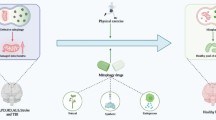Abstract
Cycad seed consumption by the native islanders of Guam is frequently associated with high rates of amyotrophic lateral sclerosis-parkinsonism dementia complex (ALS/PDC); furthermore, accompanying pathological examination often exhibits α-synuclein inclusions in the neurons of the affected brain. Acylated steryl-β-glucoside (ASG) contained in cycad seeds is considered as causative environmental risk factor. We aimed to investigate whether ASG influences aggregation and cell toxicity of α-synuclein. To understand whether ASG is a causative factor in the development of ALS/PDC, soybean-derived ASG was tested for its effect on in vitro aggregation of α-synuclein using Thioflavin-T. ASG was also tested to determine whether it modulates α-synuclein cytotoxicity in yeast cells. In addition, we determined whether an interaction between ASG and α-synuclein occurs in the plasma membrane or cytoplasm using three factors: GM1 ganglioside, small unilamellar vesicles, and ATP. In the present study, we found that ASG-mediated acceleration of α-synuclein aggregation is influenced by the presence of ATP, but not by the presence of GM1. ASG accelerated the α-synuclein aggregation in the cytoplasm. ASG also enhanced α-synuclein-induced cytotoxicity in yeast cells. This study demonstrated that ASG directly enhances aggregation and cytotoxicity of α-synuclein, which are often observed in patients with ALS/PDC. These results, using assays that replicate cytoplasmic conditions, are consistent with the molecular mechanism that cytotoxicity is caused by intracellular α-synuclein fibril formation in neuronal cells.





Similar content being viewed by others
References
Kurland LT, Molgaard CA (1982) Guamanian ALS: hereditary or acquired? Adv Neurol 36:165–171
Whiting MG (1964) Food Practices in Als Foci in Japan, the Marianas, and New Guinea. Fed Proc 23:1343–1345
Kurland LT (1988) Amyotrophic lateral sclerosis and Parkinson’s disease complex on Guam linked to an environmental neurotoxin. Trends Neurosci 11:51–54
Whiting MG (1963) Toxicity of cycads. Econ Bot 17:271–302
Cox PA, Sacks OW (2002) Cycad neurotoxins, consumption of flying foxes, and ALS-PDC disease in Guam. Neurology 58:956–959
Vega A, Bell EA (1967) α-Amino-β-methylaminopropionic acid. a new amino acid from seeds of Cycas circinalis. Phytochemistry 6:759–762
Marler T, Lee V, Shaw CA (2005) Cycad toxins and neurological diseases in Guam: defining theoretical experimental standards for correlating human disease with environmental toxins. Hortic Sci 40:1607–1611
Karamyan VT, Speth RC (2008) Animal models of BMAA neurotoxicity: a critical review. Life Sci 82:233–246
Cruz-Aguado R, Winkler D, Shaw CA (2006) Lack of behavioral and neuropathological effects of dietary beta-methylamino-l-alanine (BMAA) in mice. Pharmacol Biochem Behav 84:294–299
Yamazaki M, Arai Y, Baba M, Iwatsubo T, Mori O et al (2000) Alpha-synuclein inclusions in amygdala in the brains of patients with the parkinsonism-dementia complex of Guam. J Neuropathol Exp Neurol 59:585–591
Auluck PK, Caraveo G, Lindquist S (2010) Alpha-synuclein: membrane interactions and toxicity in Parkinson’s disease. Annu Rev Cell Dev Biol 26:211–233
Ledeen RW, Yu RK (1982) Gangliosides: structure, isolation, and analysis. Methods Enzymol 83:139–191
Martinez Z, Zhu M, Han S, Fink AL (2007) GM1 specifically interacts with alpha-synuclein and inhibits fibrillation. Biochemistry 46:1868–1877
Lo Bianco C, Shorter J, Regulier E, Lashuel H, Iwatsubo T et al (2008) Hsp104 antagonizes alpha-synuclein aggregation and reduces dopaminergic degeneration in a rat model of Parkinson disease. J Clin Invest 118:3087–3097
Roberts JJ, Walker JB (1983) Synthesis and accumulation of an extremely stable high-energy phosphate compound by muscle, heart, and brain of animals fed the creatine analog, 1-carboxyethyl-2-iminoimidazolidine(homocyclocreatine). Arch Biochem Biophys 220:563–571
Khurana R, Coleman C, Ionescu-Zanetti C, Carter SA, Krishna V et al (2005) Mechanism of thioflavin T binding to amyloid fibrils. J Struct Biol 151:229–238
Tanji K, Mori F, Kakita A, Zhang H, Kito K et al (2007) Immunohistochemical localization of NUB1, a synphilin-1-binding protein, in neurodegenerative disorders. Acta Neuropathol 114:365–371
Spillantini MG, Schmidt ML, Lee VM, Trojanowski JQ, Jakes R et al (1997) Alpha-synuclein in Lewy bodies. Nature 388:839–840
Tu PH, Galvin JE, Baba M, Giasson B, Tomita T et al (1998) Glial cytoplasmic inclusions in white matter oligodendrocytes of multiple system atrophy brains contain insoluble alpha-synuclein. Ann Neurol 44:415–422
Tabata RC, Wilson JM, Ly P, Zwiegers P, Kwok D et al (2008) Chronic exposure to dietary sterol glucosides is neurotoxic to motor neurons and induces an ALS-PDC phenotype. Neuromol Med 10:24–39
Usuki S, Ariga T, Dasgupta S, Kasama T, Morikawa K et al (2008) Structural analysis of novel bioactive acylated steryl glucosides in pre-germinated brown rice bran. J Lipid Res 49:2188–2196
Ivorra MD, D’Ocon MP, Paya M, Villar A (1988) Antihyperglycemic and insulin-releasing effects of beta sitosterol 3-beta-d-glucoside and its aglycone, beta-sitosterol. Arch Int Pharmacodyn Ther 296:224–231
Villasenor IM, Angelada J, Canlas AP, Echegoyen D (2002) Bioactivity studies on beta-sitosterol and its glucoside. Phytother Res 16:417–421
Yoon NY, Min BS, Lee HK, Park JC, Choi JS (2005) A potent anti-complementary acylated sterol glucoside from Orostachys japonicus. Arch Pharm Res 28:892–896
Matsuda H, Tokunaga M, Iwahashi H, Naruto S, Yagi H et al (2005) Studies on palauan medicinal herbs. II. Activation of mouse macrophages RAW 264.7 by Ongael, leaves of Phaleria cumingii (Meisn.) F. Vill. and its acylglucosylsterols. Biol Pharm Bull 28:929–933
Wislet-Gendebien S, Visanji NP, Whitehead SN, Marsilio D, Hou W et al (2008) Differential regulation of wild-type and mutant alpha-synuclein binding to synaptic membranes by cytosolic factors. BMC Neurosci 9:92
Ledeen R, Wu G (2011) New findings on nuclear gangliosides: overview on metabolism and function. J Neurochem 116:714–720
Wu G, Lu ZH, Kulkarni N, Amin R, Ledeen RW (2011) Mice lacking major brain gangliosides develop Parkinsonism. Neurochem Res 36:1706–1714
Fortin DL, Troyer MD, Nakamura K, Kubo S, Anthony MD et al (2004) Lipid rafts mediate the synaptic localization of alpha-synuclein. J Neurosci 24:6715–6723
Acknowledgments
This work was supported by a project grant from NIH project grants (NS 26,994 and NS 11,853) to Robert K. Yu. Thanks are due to Ms. Dawn O’Brien for her editorial assistance.
Author information
Authors and Affiliations
Corresponding author
Rights and permissions
About this article
Cite this article
Usuki, S., Kamitani, T., Matsuo, Y. et al. Pathobiochemical Effect of Acylated Steryl-β-Glucoside on Aggregation and Cytotoxicity of α-Synuclein. Neurochem Res 37, 1261–1266 (2012). https://doi.org/10.1007/s11064-011-0662-4
Received:
Revised:
Accepted:
Published:
Issue Date:
DOI: https://doi.org/10.1007/s11064-011-0662-4




